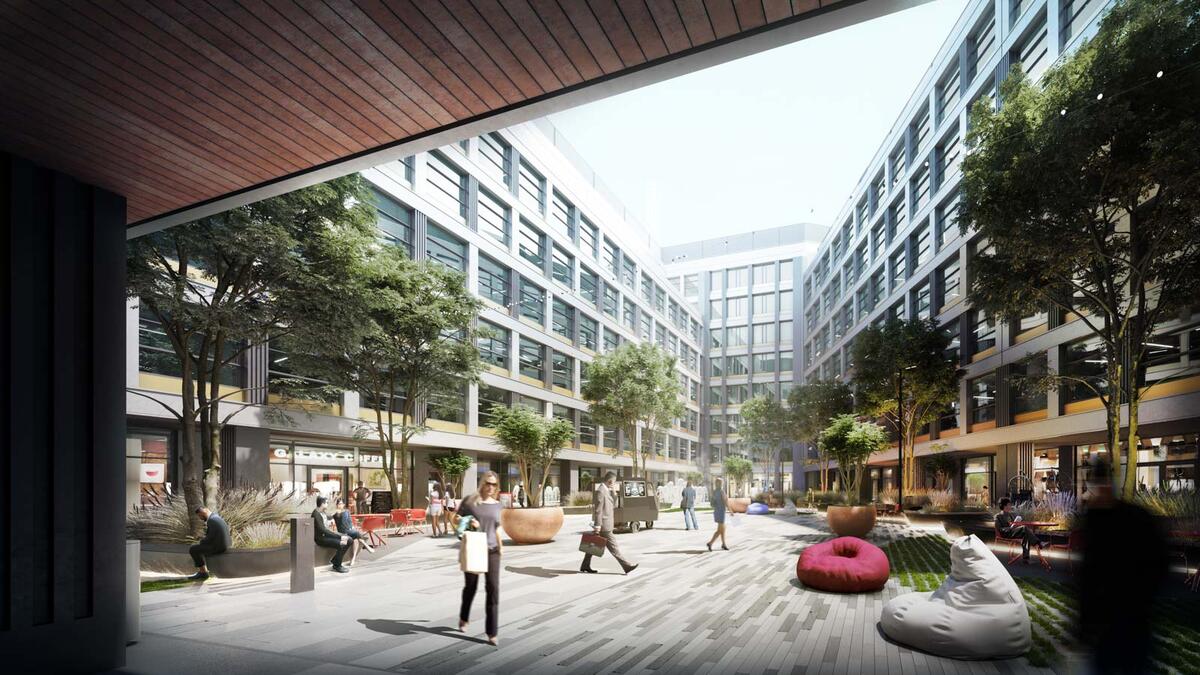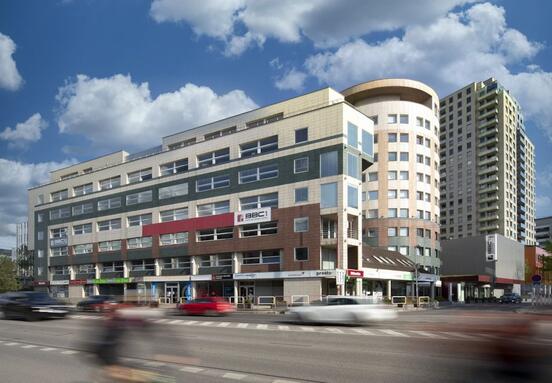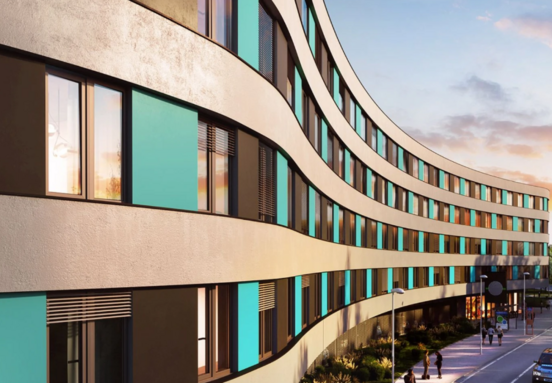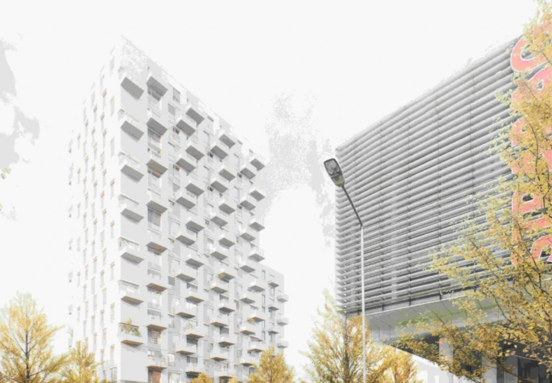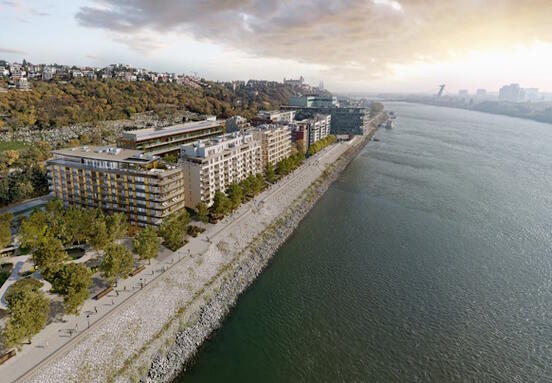The New Apollo administrative project will be created on the site of the Apollo Business Center, which was completed in 2005 and was considered the most modern business center in Bratislava. However, it was closed after only ten years. The reason was critical problems with statics, which endangered the safety of employees. After further analysis of the condition of the building, the owner decided to renovate instead of reconstructing it. In 2020, the building was definitively razed to the ground.
In its place, the New Apollo has been under preparation for a long time, which envisages the creation of an eight-story building with a central atrium, which will house 48.5 thousand square meters of office space, more than 3.5 thousand commercial and several hundred parking spaces. Originally, 484 stands were planned, but in the course of 2020, the intention to expand this capacity to 909 lots was revealed (of which 880 in the garage and 29 lots in the field). The complex should serve smaller companies, but also large shared service centers.
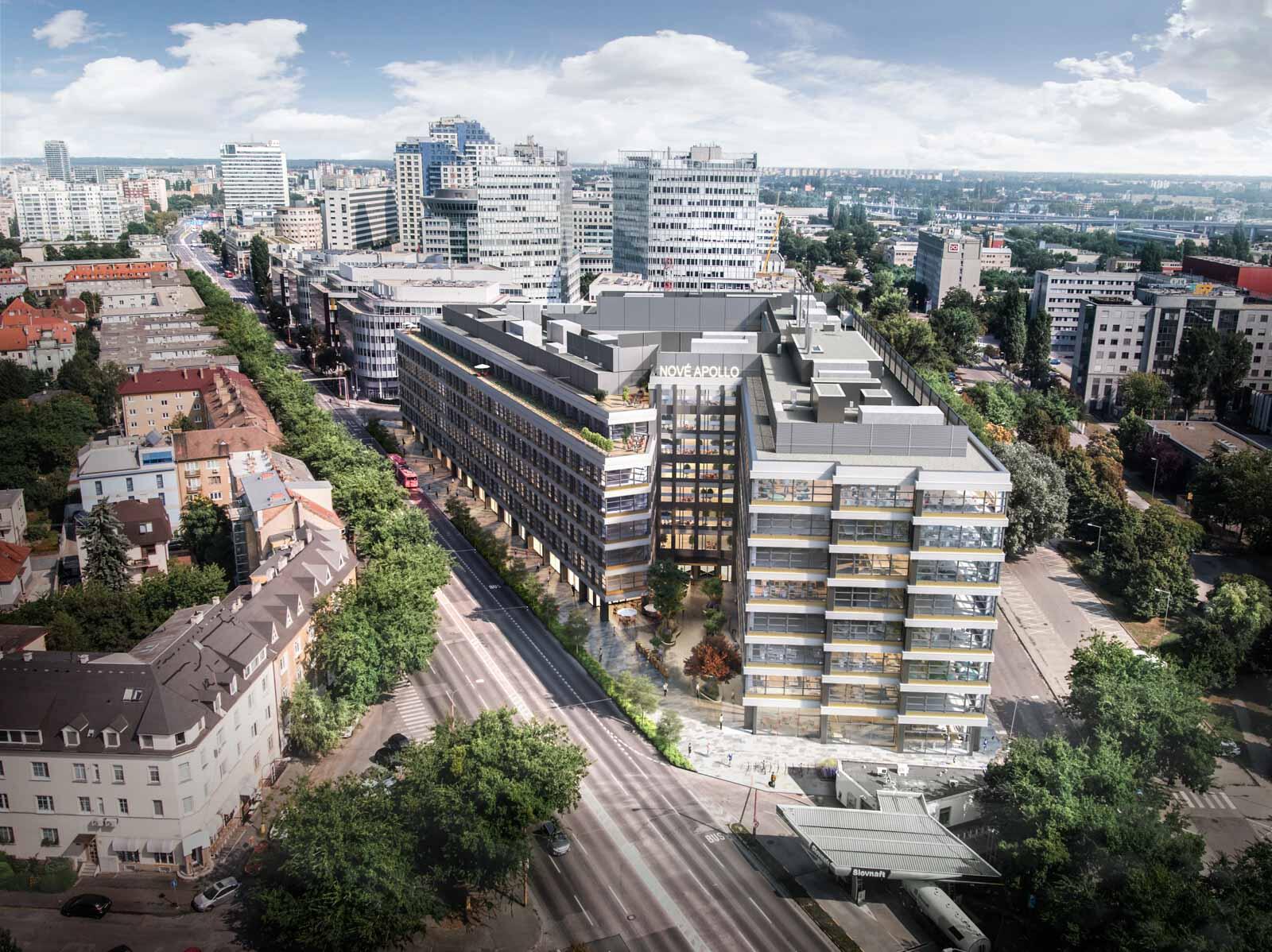
Source: HB Reavis
The project already had a building permit, but this concerned a plan with the original number of parking spaces. It is also true that it is the shared services centers that are rethinking their corporate strategies to the greatest extent - with AT&T or Johnson & Controls, for example, having to significantly reduce the number of employees in their Bratislava branches. HB Reavis thus had to postpone the start of construction, originally planned for 2020-2022. Otherwise, however, they claim that the project has not been significantly affected by the current situation.
"As part of the construction of the New Apollo, we are currently focusing mainly on the administrative side of the project, but also its design in a broader sense, for example in terms of service mix, which is always key for us, not only as a developer but also as a provider of workspaces," summarizes the current steps Sebastián Révay, spokesman of HB Reavis Slovakia. "We also design the space with regard to our other services, such as Origameo, Symbiosy or More, which provide added value to buildings and which also differentiate us in the market. Thanks to these added services, we are already able to provide projects today that will pass the tests of the future, whether it is increased hygiene standards or a healthy office in the true sense of the word. "
According to the spokesman, the pandemic did not significantly affect the appearance of the complex - and this applies to both design and occupancy. "The building with eight floors and the largest possible area of individual floors in the region will bring not only first-class offices but also facilities providing services to the local community and growing companies," explains Sebastián Révay. These services should include a bicycle club, commercial establishments, street food, or an event lobby.
The developer did not specify when he will start construction, as he does not yet have all the permits available. "The necessary administrative actions related to the permitting process are currently underway," the spokesman explains. "In addition to the above, we are currently fully concentrating our forces on the Nivy Station project, which we plan to open this year," he adds. The crane, which recently appeared in the area of the New Apollo, does not mean that construction work should currently start.
The appearance of the New Apollo is the work of the British architectural firm Make Architects, which gave the building a contemporary and more solid appearance. The business center is intended as the eastern gateway to the Nové Nivy zone, a large set of administrative and commercial projects around Mlynské nivy Street, which HB Reavis has been implementing for several years. Gradually, this part of the city becomes a kind of CBD, ie the central business district, in which Nové Apollo will play an important role.
Source: HB Reavis
The new floodplains, as well as related areas and projects from other developers, are closely connected with the future of Mlynské Nivy Street. An important city road connects the first inner-city ring road led by Dostojevský rad, Karadžičová, Legionárská, Šancová or Štefániková with an important street in the form of Košická Street, but also with the second ring road led by Bajkalská and Jarošová (and prospectively Pionierská, Pražská, Mlynská Dolina, and Einsteinová). However, the street also includes continuations towards Dunajská or Hraničná Streets.
The mill floodplains thus have a fundamental position within Bratislava, because they connect the historical center with the new center and transformation areas to the east of it. They were conceived as an important city class in the past - urban planner Antal Palóczi, author of the first comprehensive regulatory plan of Bratislava from 1917, even planned to break through the street to Hodžovo náměstí and make it the main city axis with a width of 22-50 meters. It was to end in a large city park east of today's Baikal.
Although this ambition is already unrealistic, the importance of the street should grow in the coming years. The developer, in cooperation with the Capital City, rebuilt its section between Karadžičová and Košice as an induced investment in connection with the construction of the Nivy Station, which resulted in the creation of bus lanes or cycle lanes. However, it is not yet possible to talk about the city boulevard due to several shortcomings (absence of tree lines, division of space, some elements typical of highways, etc.). The potential for its creation is only opened during the reconstruction of the next section between Košice and Baikal.
In the foreseeable future, the street could change significantly, as the construction of new multifunctional complexes, as well as the theoretical emergence of a new tram line - Prievozská radial - will lead to a change in its character. HB Reavis should also play an important role in this case. "As a developer, we participate in the form of Mlynské Nivy Street in the vicinity of the Nový Apollo project in the form of an architectural concept of a model street profile in the part between the Nové Apollo project and family houses on the opposite side," says Sebastián Révay. Katarína Rajčanová, a spokeswoman for the Municipality, also spoke earlier, according to whom the Metropolitan Institute is working on something similar.
The new Mlynské Nivy, if it is not intended to be just a transit corridor but a quality public space, will have to meet high requirements for safety, attractiveness, and aesthetics. However, this will not only be affected by the width of the sidewalks, the degree of segregation of cyclists, the presence of tree alleys, the space for public transport, or the quality of materials, but also the nature of the buildings that will affect the streets. It is essential that they turn to the street through an active ground floor with a large number of establishments and entrances to them, thus "softening" the contact between buildings and the outside environment.
The absence of an active and lively parterre is one of the great shortcomings of Bratislava, to which, unfortunately, HB Reavis also contributed by building massive Aupark shopping centers or Nivy Station. These centers vacuum life from street retail outlets and concentrate it in shopping galleries, best accessible by car. In an ideal world, it would not be difficult to imagine a long shopping street, starting on Náměstí SNP, leading across the Danube and along the Mlynské floodplains to Prievoz, complete with a tram line. In the meantime, in Petržalka, it would be appropriate to cover Einstein's and its surroundings to create multifunctional projects based around the green boulevard, which will connect Petržalka with the waterfront and the city center.
However, such a thing is hardly realistic in today's Bratislava - mainly due to the absence of a broader vision, a bad Spatial Plan, and the short-term and limited nature of public and private sector investment plans. This is the risk of many, especially office projects, the sustainability of which may not be very high - including the original Apollo, and not just because it had to be closed after ten years. The future belongs to adaptable projects that communicate with the environment. This challenge also faces the planned intentions in Nové Nivy.
Source: // YIM.BA
